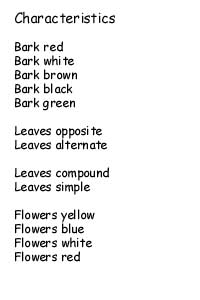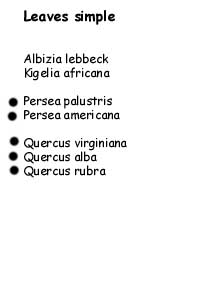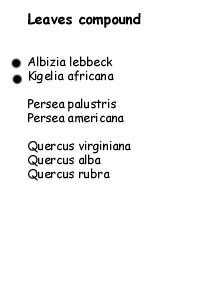
The primary useful principle of multiple access keys is that you
have a database and can search that database for all of the groups that
have a certain characteristic. You can then search the results of
the first search for all of those groups that have some other characteristic.
This goes on until you get to a single remaining group (e.g. a species)
or you run out of characteristics to search for. Even if you run
out of characteristics, you have still narrowed your possibilities dramatically
and can use other resources (e.g. pictures etc.) to identify your organism.
You don't reeally need a computer to make an interactive key but it helps.
You can make a simple database out of cards and search it manually.
Here's How to Do It.
1. Make a list of characteristics that you can observe for every organism. You won't actually need this for the final product but it will keep your thinking organized and provide a list of possible characteristics for you to refer to when you are using the key.

2. Make a list of the names of all of the possible organisms that you want to identify with a space beside it for a hole to be punched on one piece of card stock. Leave a blank space at the top as well.
3. Photocopy this card onto heavy paper or card stock several times (once for each chacteristic)
4. Now put the name of one characteristic at the top of each card and punch out a hole beside each organism that has that characteristic. Make sure that the holes (or unpunched places for them) always line up in exactly the same place on each card.


5. You are finished making your interactive key. It is that easy!
Using Your Key
To use the key you simply look observe the organism that you want to
key out and pick out the cards that have the same characteristics that
it does. Don't worry too much about getting them all on the first
run, just do the ones that you are sure about. Now stack all of the
cards neatly (all facing the same way) and hold the stack up to the light.
If you observed enough characteristics, there will be only a single name
with an open hole beside it. If there are no open holes, then you
either made a mistake in recording characteristics on the cards or in observing
the organism you want to key out. If there is more than one open
hole, then your organism is one of those with an open hole beside it and
you have already narrowed your options considerably but you need to observe
some more characteristics. This is the time to pull the cards for
characteristics that you may be less sure about. You will eventually
get to a place where you have only a single open hole or you run out of
characteristics. If you run out of characteristics to observe, then
this is the time to look at pictures or other resources for information
on the few remaining possibilities. At least now you are looking
at only a few possibilities rather than all of the ones that you started
with.